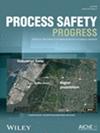An unexpected explosion while fumigating a grain silo: It wasn't the dust
IF 1
4区 工程技术
Q4 ENGINEERING, CHEMICAL
引用次数: 0
Abstract
Abstract Large‐scale fumigation of grain silos is a strategy to mitigate infestation of the bulk material. A common fumigant precursor for grain processes is aluminum phosphide, which exothermically decomposes in the presence of moisture (from the grain or air) to the toxic fumigant: phosphine gas. To overcome the hazards of exothermic decomposition and phosphine exposure, aluminum phosphide pellets can be metered into the silo's grain feed to distribute them throughout the grain more evenly. This approach decreases the decomposition rate of aluminum phosphide, better distributes heat generation to avoid igniting grain, and sustains a phosphine gas concentration well below the pyrophoric concentration—all while achieving the fumigation objectives. During a fumigation activity, a large explosion occurred within a group of silos at a grain elevator complex. Dust explosions are a common hazard for grain handling facilities, but this incident was caused by the autoignition of a phosphine gas cloud inside the conveyor tunnels. It was only through post‐incident evaluations of the grain flow dynamics and pellet addition activities that a gap between the desired pellet distribution and the incident conditions was identified. As a result, a new insight into bulk grain handling and safe fumigation was developed.在对粮仓进行熏蒸时发生意外爆炸:原因不是灰尘
摘要粮食仓的大规模熏蒸是一种减轻散装物料侵染的策略。谷物加工中常见的熏蒸剂前体是磷化铝,它在水分(来自谷物或空气)的存在下放热分解成有毒的熏蒸剂:磷化氢气体。为了克服放热分解和磷化氢暴露的危害,可以将磷化铝颗粒计量到筒仓的粮食饲料中,使其更均匀地分布在整个粮食中。这种方法降低了磷化铝的分解速度,更好地分配热量以避免点燃颗粒,并保持磷化气浓度远低于焦氧浓度,同时实现了熏蒸目标。在一次熏蒸作业中,在一个粮食升降机综合设施的一组筒仓内发生了一次大爆炸。粉尘爆炸是粮食处理设施的常见危险,但这次事故是由传送带隧道内的磷化氢气云自燃引起的。只有通过事件后对颗粒流动动力学和颗粒添加活动的评估,才能确定所需颗粒分布与事件条件之间的差距。因此,对散装粮食处理和安全熏蒸有了新的认识。
本文章由计算机程序翻译,如有差异,请以英文原文为准。
求助全文
约1分钟内获得全文
求助全文
来源期刊

Process Safety Progress
工程技术-工程:化工
CiteScore
2.20
自引率
10.00%
发文量
99
审稿时长
6-12 weeks
期刊介绍:
Process Safety Progress covers process safety for engineering professionals. It addresses such topics as incident investigations/case histories, hazardous chemicals management, hazardous leaks prevention, risk assessment, process hazards evaluation, industrial hygiene, fire and explosion analysis, preventive maintenance, vapor cloud dispersion, and regulatory compliance, training, education, and other areas in process safety and loss prevention, including emerging concerns like plant and/or process security. Papers from the annual Loss Prevention Symposium and other AIChE safety conferences are automatically considered for publication, but unsolicited papers, particularly those addressing process safety issues in emerging technologies and industries are encouraged and evaluated equally.
 求助内容:
求助内容: 应助结果提醒方式:
应助结果提醒方式:


